Part IV
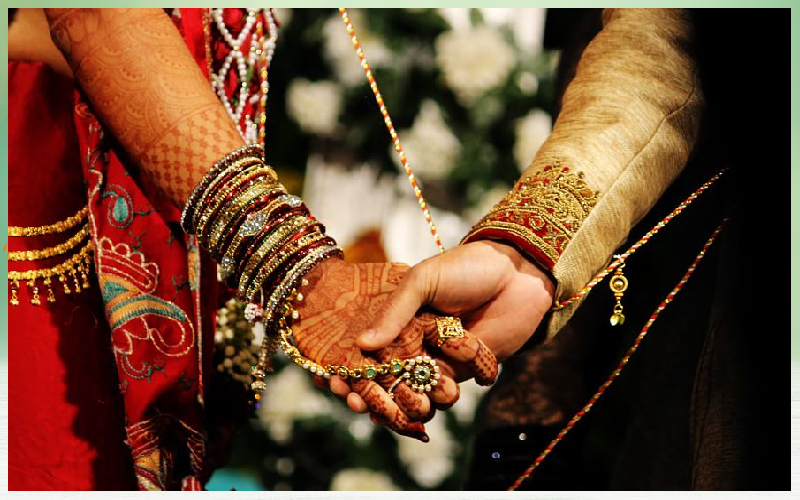
Pradhaana Homam – The Main Sacrificial Ritual
After Sapthapadi, the couple take their seat on the western side of the sacred fire and conduct Pradhaana Homam. During the conduct of this Homam, the bride must place her right hand on her husband’s body so that she gets the full benefit of participation. For the sake of a successful married life, the bridegroom seeks the blessings of Lord Indra and other deities to endow them with.
1. Ten children and requests that he blessed to become the eleventh child of his bride in his old age.
2. Health and longevity of the bride, himself, and the children (To be born).
3. Freedom from diseases and other inauspicious events and removal of all Pāpā-s (Sins).
4. Mutual goodwill and harmony in the family.
5. The bride is blessed to completely identify with the bridegroom’s family.
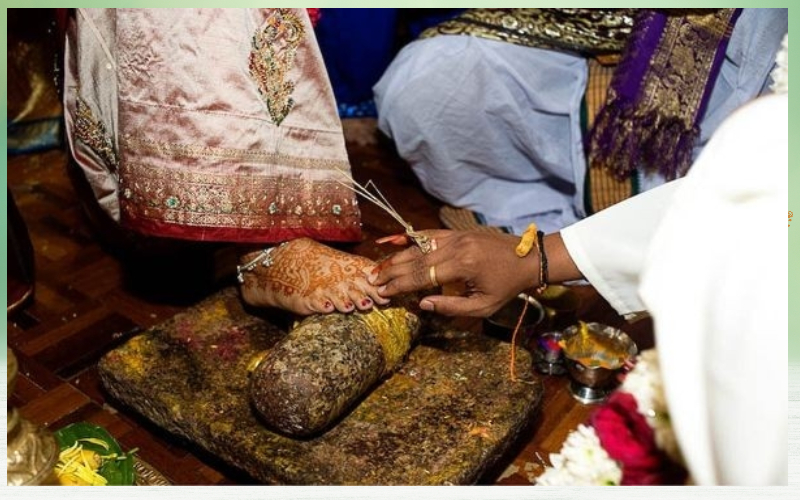
Asmaarohanam – Stepping on the Grinding Stone
After Pradhaana Homam, the husband holds the right toe of his wife and lifts her leg and places it on a flat granite grinding stone known as ‘Ammi’ in Tamil. The Ammi is placed at the right side of the sacred fire. The husband recites a Veda Mantrā when he places the right foot of his wife on the Ammi, meaning: May you stand on this firm stone! May you be strong and unshakable like the stone! May you face the challenges of life! May you stand up to those who oppose you while you carry out your time-honored responsibilities as a wife sanctioned by the Vedas and the tradition! May you develop tolerance to your enemies and put up a fair fight to defend your legitimate rights as the head of the household in a firm manner, equal to the steady strength of this grinding stone!
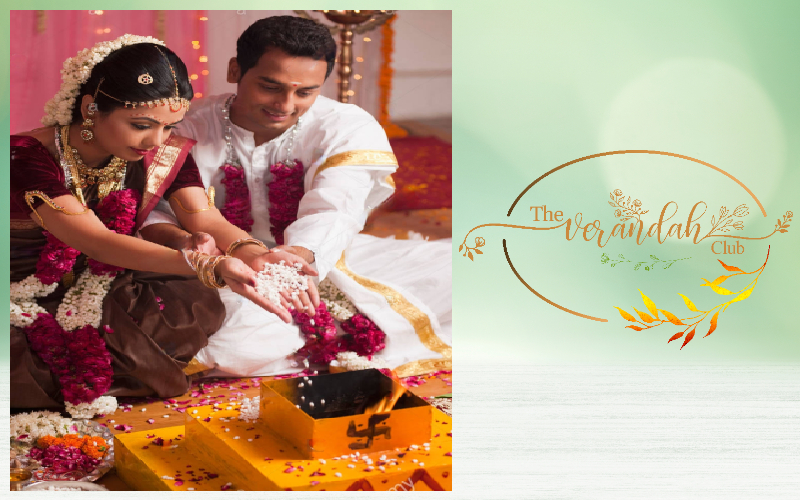
Laaja Homam – offering puffed rice into the fire
After Ammi stepping, a ceremony of doing a Homam with parched rice (‘Pori’ in Tamil) is conducted. Here, the wife cups her hands, and her brothers fill the cupped hand with the parched rice. The husband adds a drop of ghee to the parched rice and recites the five Veda Mantrā-s. At the end of each Mantrā, the parched rice is thrown into the sacred fire as Hāvī-s (Offerings) to Agni. Through these Mantrā-s, the wife prays for her husband and a married life filled with peace and harmony. After each offering, the couple go round the fire thrice and the bride steps on the stone as mentioned in the previous section. The three Mantrā-s chanted during the circumambulation (Pradakṣiṇā) and the Mantrā chanted while the bride steps on the stone are repeated after each offering of the puffed rice. Through all these Mantrā-s, prayers are offered for the following: longevity of the couple, progeny, prosperity, harmony, and capacity to face difficulties in life.
After the Laajahomam and the chant of two Mantrā-s, the groom removes the darbha girdle (ties after Maangalya Dhaaranam) of the bride. With this, all the Vedic ceremonies come to an end.
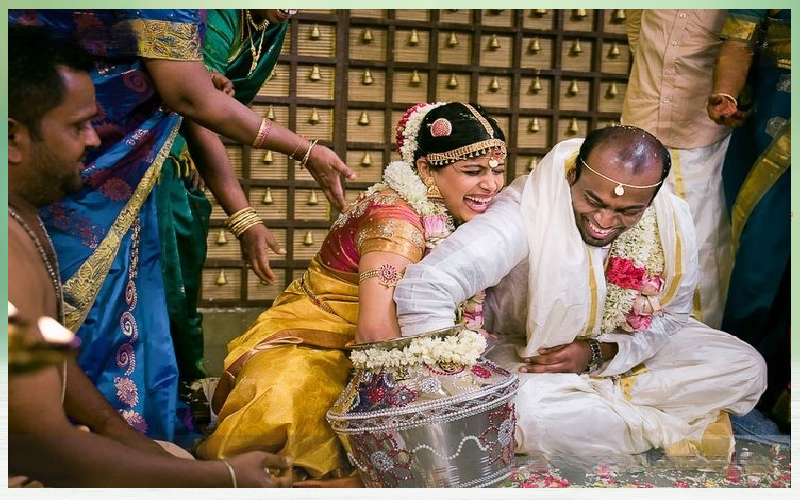
Nalangu
It is celebrated after the completion of the marriage rituals. This is basically performed to bring the two families together and ease the tension of all the rituals. The groom is decorated by the bride and vice versa. In all these events all relatives are given a role to play so that there will be sense of participation. There will be lot of fun, music etc., during Nalangu.
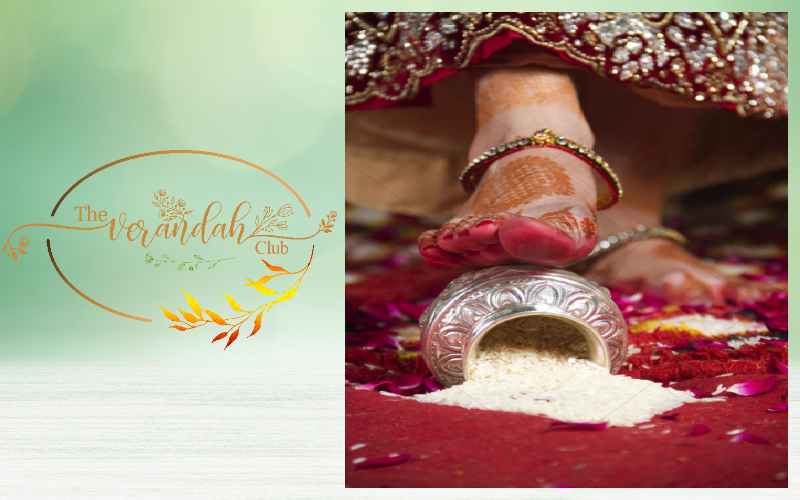
Grihapravesham and Praveshahomam
At the end of all Vedic and non-Vedic rituals, the couple leaves for the groom’s house carrying the sacrificial fire and this is supposed to be maintained till the last ritual in one’s life. Many Mantrā-s are chanted for the safe travel etc., and all these have become irrelevant these days due to the change in lifestyle, modes of travel, etc.
On reaching home, prayers are chanted to thank all the Devatā-s for the safe conduct of everything. The girl is asked to keep her right foot forward on entering the house for auspiciousness. She claims, “I enter into this auspicious and prosperous house with all noble intentions.”
After this, Praveshahomam is performed for progeny, health, wealth, longevity, and non-separation of husband and wife. In some families, a child is kept on the lap of the bride and she gives fruits to the child in a symbolic way. After blessing the couple, all the relatives and virtuous life like that of Arundathi.
In the evening, the husband shows the pole star (Dṝuvadarṣanaṃ) to infuse steadiness in her mind. He later shows the Arundathi star to inspire her to lead a glorious and virtuous life like that of Arundathi.
At the end of all the rituals, the husband touches the heart of his wife and propriates all gods and goddesses for a mutually affectionate life. With a few final prayer verses addressed to gods like Prajāpati and Sūrya for their welfare, favorable attitude and cooperation of the wife for their conjugal union, the entire ceremonies come to an end.
Conclusion
The rich and the meaningful ceremony of the Hindu marriage is thus carried out in concert with sacred Veda Mantrā-s. The bride and the bridegroom should enunciate clearly the Veda Mantrā-s and reflect on their meanings during the different stages of marriage ceremony. This way, they can be sure of long, happy, and prosperous married life and fully play their appropriate roles in the society.
Among all the rites performed in a wedding, ‘Kanyakaadhaanam’, ‘Maangalyadhaaranam’, ‘Paanigrahanam’ and ‘Sapthapadi’ are said to be very important. The wedlock is solemnized after the performance of ‘Sapthapadi’ and a meaningful relationship of the lifetime gets established with the sacred fire as witness. A life of harmony and companionship awaits the couple. This is the spirit of the sacrament of wedding according to our tradition. The Sanskrit word for marriage, Vivāhā, means to support, to sustain. Support what? Dharmā (A way of life as laid down by one’s religion), is the answer. The full significance of the marriage ceremony is inherent in that word.
To look after home and family, according to the rules of Dharmā, calls for good qualities and character.
Marriage is the vital life force that pulsates within the heart of the bride and the groom and the ultimate reward are the children who, in turn carry this torch into society, nation, and world over again.
Lokā Samasthā Sukino Bhavantu
May all the beings, in all the worlds, be happy!
NEXT ARTICLE
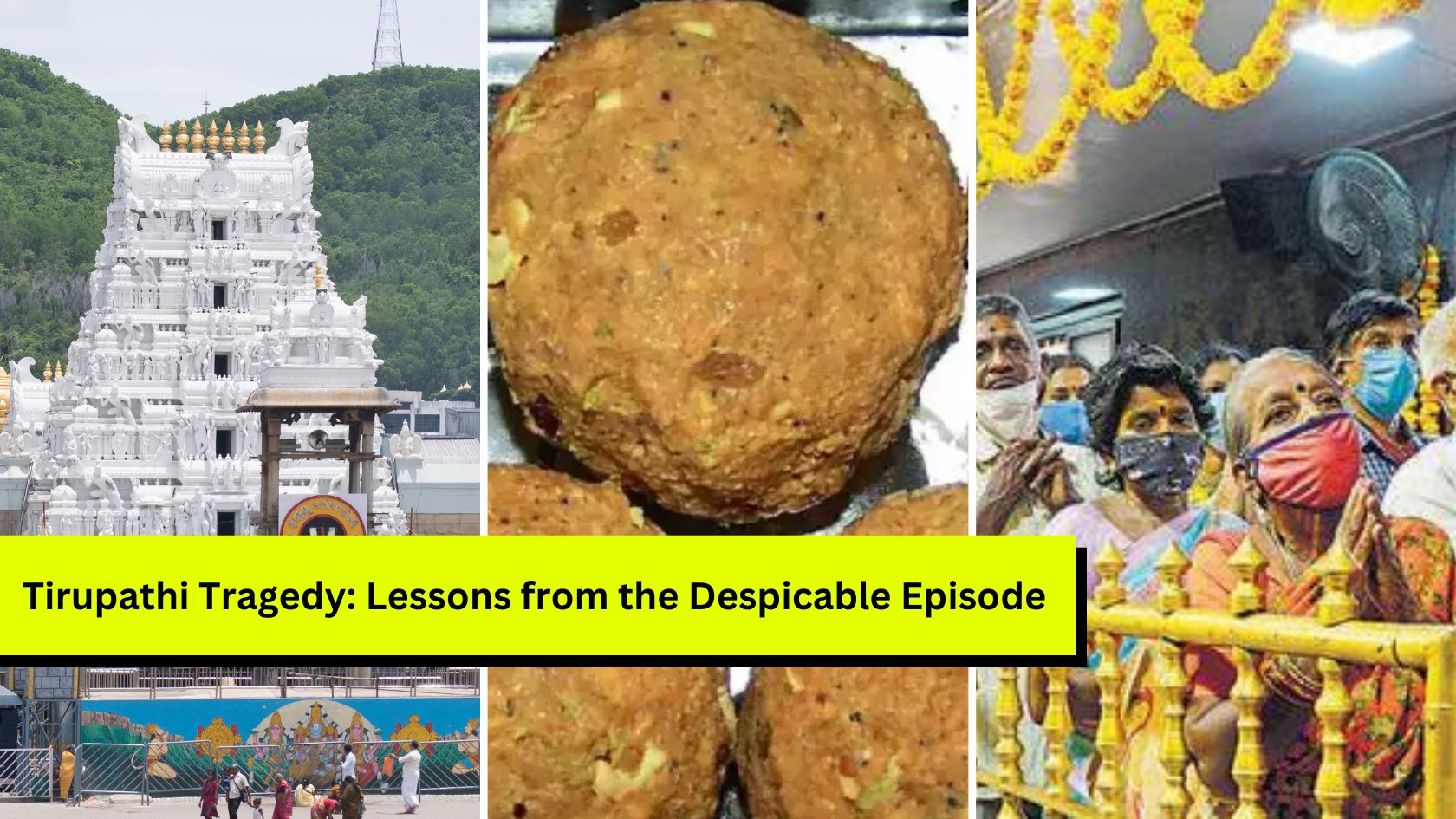
The Venkateshwara Swami Temple in Tirupati is among the holiest places in the world for Hindus. Millions of people throng the temple every year to get...
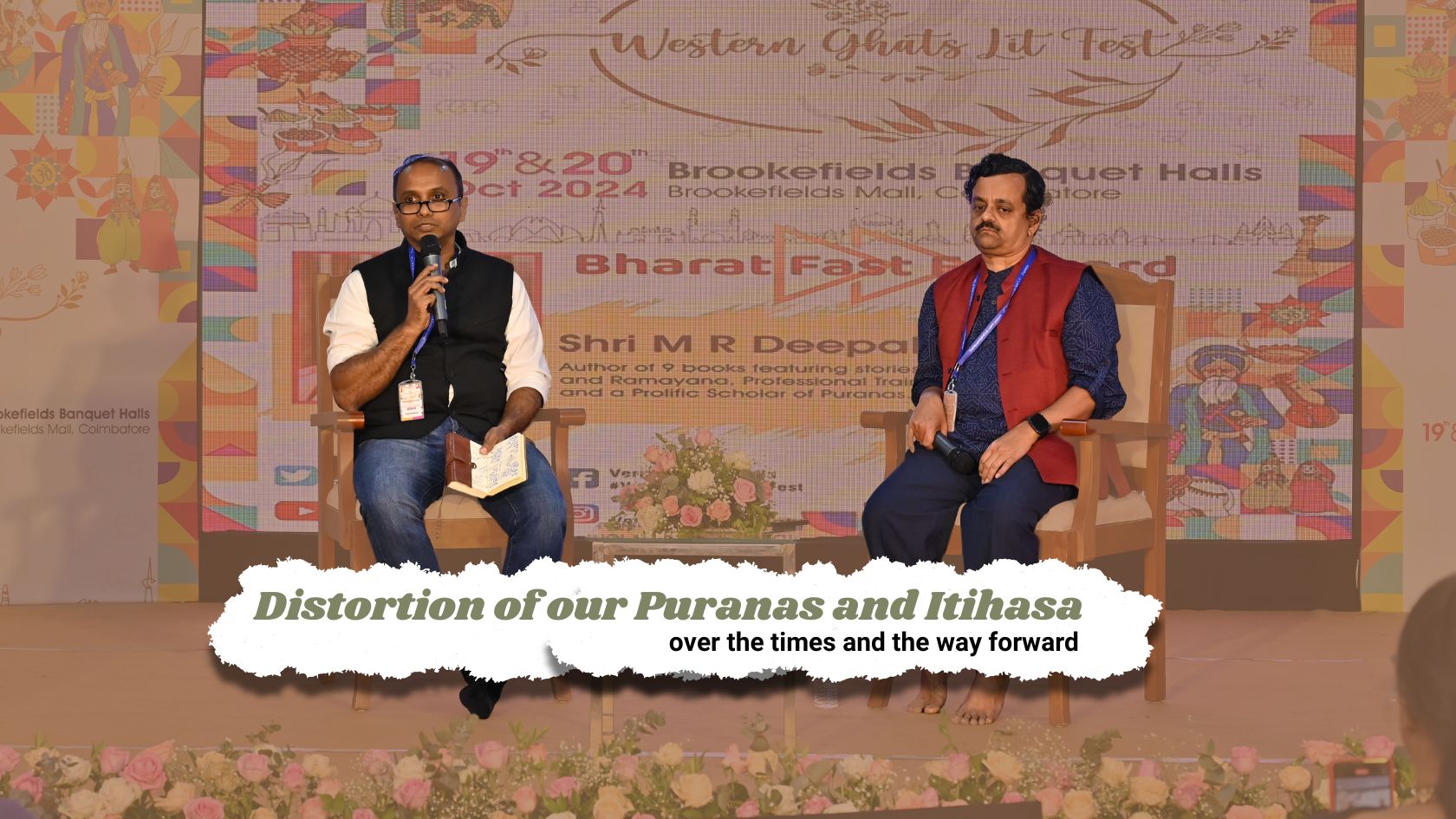
It is a sad reality that our Itihasa and Puranas have been subject to severe distortion over the years. This is not surprising considering how even th...
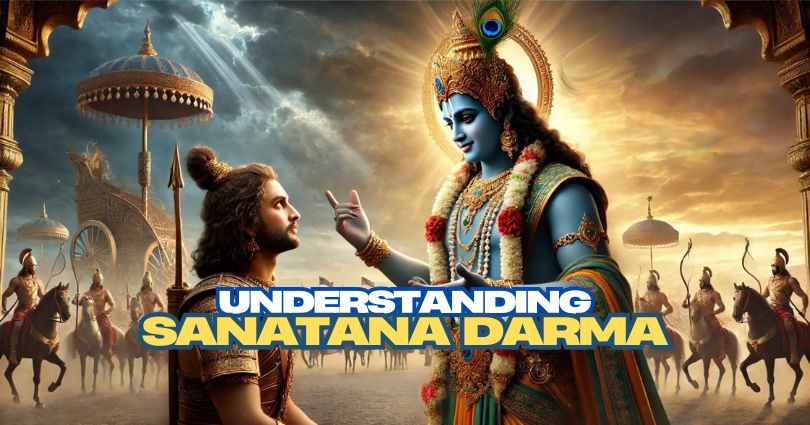
The holy land of Bharat follows Sanatana Dharma. The word Sanatana Dharma is a Sanskrit word meaning, “Eternal law”. It is the indestructible ultimate...